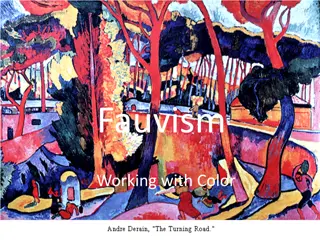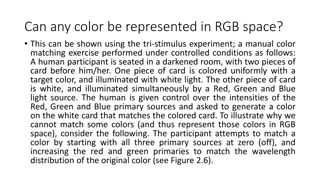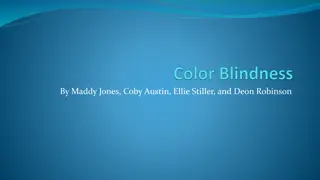Understanding Color Vision in Primates and Mammals
Explore the fascinating world of color vision in primates and other mammals through trichromatic and dichromatic color vision systems. Discover how dichromats and trichromats perceive colors differently due to the types of color-detecting cells in their retinas. Learn why most mammals are dichromats while many primates are trichromats, and delve into activities that highlight the advantages of trichromacy in detecting objects in natural environments.
Download Presentation

Please find below an Image/Link to download the presentation.
The content on the website is provided AS IS for your information and personal use only. It may not be sold, licensed, or shared on other websites without obtaining consent from the author. Download presentation by click this link. If you encounter any issues during the download, it is possible that the publisher has removed the file from their server.
E N D
Presentation Transcript
Teaching Workshop: Color Vision in Primates and Other Mammals Carrie C. Veilleux & Amber Heard-Booth Anthropology Department, University of Texas at Austin
Trichromat Dichromat http://www.colblindor.com/coblis-color-blindness-simulator/
How does this work? Dichromats have 2 types of color-detecting cells in the retinas in their eyes: Blue-sensitive cones Yellow/green-sensitive cones
Dichromat Green cone - Blue cone
How does this work? Trichromats have 3 types of color- detecting cells in the retinas in their eyes: Blue-sensitive cones Yellow/green-sensitive cones Red-sensitive cones
Dichromat Trichromat Red cone Green cone - - Green cone Blue cone - Blue cone
Activity: Why be a trichromat? Hypothesis: Trichromacy is beneficial for detecting red food objects in a green leaf background.
Activity: Why be a trichromat? Hypothesis: Trichromacy is beneficial for detecting red food objects in a green leaf background.
Activity: Why be a trichromat? Based on an experiment done in marmoset monkeys Some individuals were dichromats, some individuals were trichromats Monkeys foraged for orange or green Kix cereal in green wood shavings
Basic Activity Before beginning the experiment, students determine their color vision type (trichromat or dichromat) IMPORTANT: Up to 10% of men are red-green colorblind and so have dichromatic color vision.
Dichromats see a square Trichromats see a square and a circle
Dichromatic people and animals can actually detect camouflaged objects better than trichromats! 73 5 45
Basic Activity Experiment has 2 parts: #1: Forage for green pompoms in green foliage #2: Forage for red pompoms in green foliage
Basic Activity Goals: 1. Identify possible benefits of having trichromatic color vision for primates. 2. Identify benefits of having dichromatic color vision. 3. Explore the effects of red-green colorblindness in humans Handouts offer several ways this activity can be adapted for different grade levels. Handouts and slides are available online at: http://www.carriecveilleux.com/teaching























